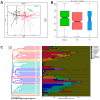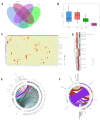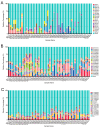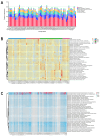Metagenomic and Antibiotic Resistance Analysis of the Gut Microbiota in Larus relictus and Anatidae Species Inhabiting the Honghaizi Wetland of Ordos, Inner Mongolia, from 2021 to 2023
- PMID: 38792807
- PMCID: PMC11123678
- DOI: 10.3390/microorganisms12050978
Metagenomic and Antibiotic Resistance Analysis of the Gut Microbiota in Larus relictus and Anatidae Species Inhabiting the Honghaizi Wetland of Ordos, Inner Mongolia, from 2021 to 2023
Abstract
Gut microbes thrive by utilising host energy and, in return, provide valuable benefits, akin to a symbiotic relationship. Here, metagenomic sequencing was performed to characterise and compare the community composition, diversity and antibiotic resistance of the gut microbiota of Relict gull (Larus relictus) and Anatidae species. Alpha diversity analysis revealed that the intestinal microbial richness of L. relictus was significantly lower than that of Anatidae, with distinct differences observed in microbial composition. Notably, the intestines of L. relictus harboured more pathogenic bacteria such as clostridium, which may contribute to the decline in their population and endangered status. A total of 117 strains of Escherichia coli were isolated, with 90.60% exhibiting full susceptibility to 21 antibiotics, while 25.3% exhibited significant biofilm formation. Comprehensive Antibiotic Resistance Database data indicated that glycopeptide resistance genes were the most prevalent type carried by migratory birds, alongside quinolone, tetracycline and lincosamide resistance genes. The abundance of resistance genes carried by migratory birds decreased over time. This metagenomic analysis provides valuable insights into the intestinal microbial composition of these wild bird species, offering important guidance for their conservation efforts, particularly for L. relictus, and contributing to our understanding of pathogen spread and antibiotic-resistant bacteria.
Keywords: Anatidae; Escherichia coli; Larus relictus; biofilm; gut microbiota; metagenomic.
Conflict of interest statement
The authors declare no conflicts of interest.
Figures







Similar articles
-
Comparative analysis of the gut bacteria of the relict gull (Larus Relictus) and black-necked grebe (Podiceps Nigricollis) in Erdos Relic Gull National Nature Reserve in Inner Mongolia, China.PeerJ. 2023 Jul 10;11:e15462. doi: 10.7717/peerj.15462. eCollection 2023. PeerJ. 2023. PMID: 37456862 Free PMC article.
-
Comparative Analysis of Gut Bacteria of Four Waterbirds Species in Taolimiao-Alashan Nur (T-A Nur) in Erdos Relic Gull National Nature Reserve, Inner Mongolia, China.Ecol Evol. 2025 May 13;15(5):e71432. doi: 10.1002/ece3.71432. eCollection 2025 May. Ecol Evol. 2025. PMID: 40370353 Free PMC article.
-
Comparative Analysis of the Fecal Microbiota of Relict Gull (Larus relictus) in Mu Us Desert (Hao Tongcha Nur) and Bojiang Haizi in Inner Mongolia, China.Front Vet Sci. 2022 Apr 6;9:860540. doi: 10.3389/fvets.2022.860540. eCollection 2022. Front Vet Sci. 2022. PMID: 35464369 Free PMC article.
-
Metagenomic and network analysis revealed wide distribution of antibiotic resistance genes in monkey gut microbiota.Microbiol Res. 2022 Jan;254:126895. doi: 10.1016/j.micres.2021.126895. Epub 2021 Oct 23. Microbiol Res. 2022. PMID: 34742104 Review.
-
Eubiotic properties of rifaximin: Disruption of the traditional concepts in gut microbiota modulation.World J Gastroenterol. 2017 Jul 7;23(25):4491-4499. doi: 10.3748/wjg.v23.i25.4491. World J Gastroenterol. 2017. PMID: 28740337 Free PMC article. Review.
Cited by
-
Inter-year consistencies and discrepancies on intestinal microbiota for overwintering relict gulls: correlations with food composition and implications for environmental adaptation.Front Microbiol. 2024 Dec 9;15:1490413. doi: 10.3389/fmicb.2024.1490413. eCollection 2024. Front Microbiol. 2024. PMID: 39736995 Free PMC article.
References
Grants and funding
LinkOut - more resources
Full Text Sources
Molecular Biology Databases

